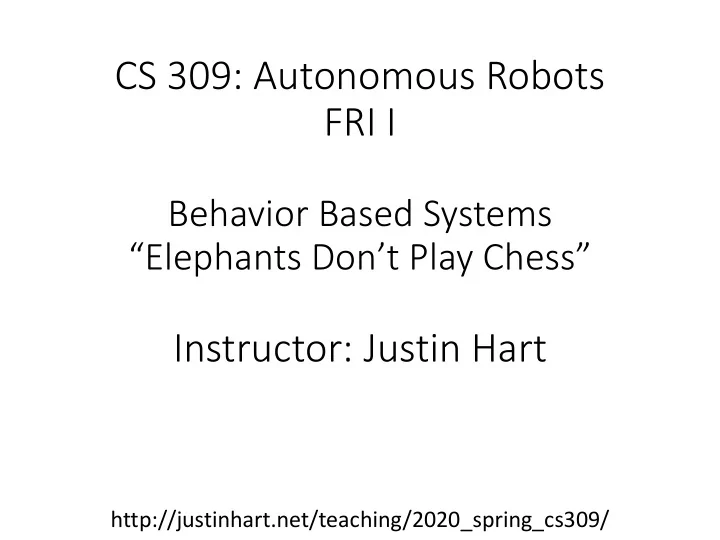

CS 309: Autonomous Robots FRI I Behavior Based Systems “Elephants Don’t Play Chess” Instructor: Justin Hart http://justinhart.net/teaching/2020_spring_cs309/
The Symbol System Hypothesis Newell & Simon (Turing Award Lecture) “a physical symbol system [such as a digital computer, for example] has the necessary and sufficient means for intelligent action.” This is a very general statement that can be taken to mean that computers can be intelligent
Elephants Don’t Play Chess Traditional vs Nouvelle AI • Traditional • Uses classical reasoning in impoverished domains • Chess, other games, “toy” problems • PDDL & its cousins • PDDL was not written at the time of the paper • Nouvelle • Uses less sophisticated reasoning in richer domains
Big Idea - Embodiment Term is not used in the paper, but concept is central A physical robot is embedded in the real world, rather than in a model
Big Idea - Situation It is important to use a robot, because you interact with the real world rather than a simulation “The world is its own best model” The argument is that STRIPS and PDDL solve only model problems, and do not translate well to the real world. grasp(gripper, can) Does not capture what it means to grasp a can.
Big Idea – Emergent Behavior Many simple behaviors give rise to complex, intelligent behavior
Ideas seemingly at odds with each other • Symbol System Hypothesis • Behavior-Based Hypothesis • Simulations/Games • Embodiment/Situation • Acting on “world models” • The world is its own best model
Why is Brooks picking on chess? (define (domain blocks-world) (:requirements :typing) (:types block gripper table) (:predicates (empty ?g - gripper) (clear ?b - block) (stacked ?a - block ?b - block) (on-table ?a - block ?b - table) (in-gripper ?b - block ?g - gripper) ) (:action grasp :parameters (?g - gripper ?b - block) :precondition (and (clear ?b) (empty ?g)) :effect (and (not (clear ?b)) (not (empty ?g)) (in-gripper ?b ?g)) ) )
In Brooks’s view, the best known robot at the time was a chess player
Herbert
Ghenghis
Toto
Cog & Kismet
Traditional Robot Architectures • Sense-Think-Act cycles • Do sensing • Run planner • Act on plan • Sensors • Metabolize data into “world models” • World models can be reduced to atoms in languages like PDDL • Think • Run your planner -> PDDL • Act • Execute the plan
Behavior-Based Architectures • Behavior-based systems were in part a departure from this • Some of the ideas involve low processing power, cheap to build & deploy systems • This allows you to do many experiments • Remember, this was the 90s. Processing power was limited in general. • Some of these systems scaled WAY up • Cog used a custom supercomputer
Finite State Machines B 1 1 2 A D 0 2 C 1
Augmented Finite State Machines • Add registers and timers to FSMs • A timer or register can control a state transition • A register can go to a sensor, actuator, or another AFSM B 1 1 2 A D 0 2 1 C
Subsumption • Dictates how AFSMs interact • Describes how simple behaviors combine • Inhibit → Prevent a signal from being transmitted between AFSMs • Suppress → Replace a signal with another • Layered behaviors → Higher -level behaviors can control lower-level ones
Ghenghis’s Subsumption Architecture Diagram
Boids • Simulates flocking birds • Swarm intelligence • Swarm behaviors • Try to maintain this minimal distance • Follow the one in front of you • Similar behaviors • https://www.youtube.com/watch?v=GUkjC-69vaw
Massive • Commercial system, similar to Boids • Used in films • https://www.youtube.com/watch?v=cr5Cwz-5Wsw
Emergent behavior in Boids • The simple behaviors group together to give a large, globally intelligent behavior of the swarm • Subsumption works differently, but the idea is to combine simple behaviors to produce bigger intelligent behavior
Motor Schemas
Motor Schemas
Motor Schemas
Hybrid Architectures • People have combined behavior-based architectures and planning- based sense-think-act style architectures • AuRA – Autonomous Robot Architecture • 3T – 3 Tiered • SSS – Servo, Subsumption, Symbolic
How does this impact us now? • The ideas survived, but the field moved forward • Robots are still referred to as having “behaviors” • In “Elephants Don’t Play Chess,” Brooks takes shots at “world models” and robot models such as kinematic models • These days, these types of models are heavily used • What happened? • Vision got better! Computers got better! Techniques caught up. • The ideas from this school of thought live on and influenced newer systems.
Recommend
More recommend